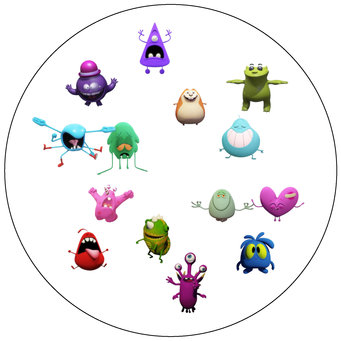How Our Brain Makes New Decisions
Scientists have investigated the underlying mechanism in the brain when we apply stored knowledge to new decision-making situations.
Scientists have investigated the underlying mechanism in the brain when we apply stored knowledge to new decision-making situations.
APRIL 03, 2023
How does the brain deal with new situations? How does it make decisions? Together with other Max Planck colleagues, Mona Garvert and Christian Doeller have investigated the underlying mechanism in the brain when we apply stored knowledge to new decision-making situations.

The scientists assumed that the brain generates a mental "knowledge map" about the virtual monster world.
© MPI CBS
We regularly find ourselves in new shops or restaurants, we land at airports we don't know or start a new job. In such situations, the remarkable flexibility of human behaviour becomes apparent. Even in new situations, we can often predict the consequences of our actions and thus make appropriate decisions.
How does the brain manage to make adequate decisions in situations we have never experienced before? One assumption is that in such situations the brain draws on experiences we have had in similar situations in the past. Experiences in other restaurants, for example, have prepared us well for what to expect in a new pizzeria. This requires a meaningful organisation of this experiential knowledge in the brain, as well as flexible access to this knowledge in new decision-making situations.
Mona Garvert and Christian Doeller from the Max Planck Institute for Human Cognitive and Brain Sciences, together with colleagues from the Max Planck Institutes for Human Development in Berlin and for Biological Cybernetics in Tübingen, have now investigated in a study recently published in Nature Neuroscience, which mechanism in the brain underlies when we apply stored knowledge to new decision-making situations. For this purpose, 48 study participants navigated through a virtual room. Small friendly monsters appeared at certain places - over time, the participants learned which monsters were "sitting" in which places. In this way, the scientists assumed, the brain generates a mental "knowledge map" about the virtual monster world.
Mona Garvert and her colleagues were able to observe that the trajectories of study participants through the virtual space differed greatly - some always walked along the edge, others more systematically from top to bottom, some more star-shaped. "This means that the order in which the monsters were seen differed between individuals. For example, the participants running in a star shape saw the monsters at very different time intervals than the participants navigating the room systematically from top to bottom," the neuroscientist explains.
Later, the study participants had to choose between two monsters. Monsters that were close to each other in the virtual room earned a similar number of points. So those who were clever used their prior knowledge about the location of the monsters and chose monsters that were as close as possible to a monster that had previously brought many points. "The study participants did just that - showing us that they used their stored knowledge for this task. Interestingly, they drew on both their knowledge of spatial and temporal relationships learned in association with the monsters to make these decisions. In the MRI scanner, we could then see that those who had a stronger spatial representation of the monsters in their brains were also more influenced by the spatial relationships in their decision-making behaviour. In those who had a stronger temporal representation, the influence of the temporal relationships was stronger. We were thus able to demonstrate that the brain uses spatial and temporal knowledge maps for decision making and also adapts them when it learns through reward."
Christian Doeller, director at the Max Planck Institute for Human Cognitive and Brain Sciences, adds: "Taken together, we have demonstrated in the study how the brain's cognitive maps are flexibly used and updated for reasoning. If we find ourselves in a situation we have never experienced before, we draw on mapped knowledge in our hippocampus to act adequately in the new situation."
Mona Garvert assumes that the results could also have implications for our understanding of mental illness. Patients with anxiety disorders and depression, for example, often transfer negative experiences to neutral situations. This could be related to how knowledge is organised in mental maps. Further studies could be helpful here to decipher the mechanism in the brain in an aversive context.
Publication: Mona M. Garvert, et al., Hippocampal spatio-predictive cognitive maps adaptively guide reward generalization, Nature Neuroscience (2023). DOI: 10.1038/s41593-023-01283-x.
Original Story Source: Max Planck Institute for Biology

 Alerts Sign-up
Alerts Sign-up